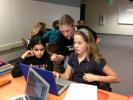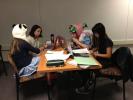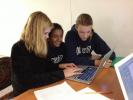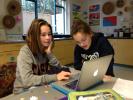Co-Teaching to Use Scratch Across the Curriculum: An Interview with Ann Greyson of Castilleja School
Ann Greyson is a Computer Science teacher working on integrating Scratch across the middle school curriculum. How? She co-teaches with subject teachers at Castilleja School in Palo Alto, California. In its third year of implementation, Castilleja’s STEM program emphasizes STEM (Science, Technology, Engineering, Mathematics) fields in the middle school by incorporating STEM-related topics into content areas, which means that rather than requiring Computer Science as a separate subject, they integrate technology across curricular subjects using Scratch.
“The way we structure it right now, we have approximately one week set aside in each of four content areas, where I come in and I co-teach with that content area teacher. The first one was seventh grade Science. I spent an entire week with Christina Nawas’s seventh grade science class, one day just totally devoted to a tutorial on Scratch, and then the rest of the week, the students were designing and programming their animations. Next, Carolyn Steele, the seventh grade math teacher, has this whole project around building Math games in Scratch.”

Castilleja’s approach with middle school students is to introduce Scratch in a way that progressively challenges them to experiment with new programming concepts and build upon previous work. “The first project was an animation project and there was no user interaction at all. By the end of the year, they’ll be doing everything.”
.jpg)
Discussing the various projects that students will be working on throughout the year, Ann further illustrates how Scratch is being incorporated across the curriculum, “In Science class, the students learned about molecular processes, and so they were given a choice of osmosis, diffusion, protein synthesis, DNA Replication or mitosis. Pairs of students were tasked with creating an animation of one of the processes. The Scratch project for Math is an interactive Math game and the students have a choice of seven different games: guess my number, find the factors, fraction conversions, find the pair (product and sum), guess my rule, fraction line up, and 21. In Evelyne Nicolaou’s French class, they add audio and animate a Babar story, and Eugenie Paick’s History project is to create an interactive museum exhibit about a European explorer.”

The middle school team feels that using Scratch helps provide powerful and motivating learning experiences for students of various interests. “We were kind of waiting to hear it and then it happened -- the very first time that they saw the cat glide across the screen to where they had programmed it to go, they're all going ‘WOW! That's so cool!’ It also has something for everyone, so you can be interested in programming and have a ball with it, but if what you really like is designing sprites, you can customize sprites using the paint editor. Scratch is so engaging that students feel compelled to continue to bang away at something and make it work even though they’re having trouble. It encourages that persistence which we are trying to foster here.”

The student response has also been very encouraging. On a recent survey, students gave extremely positive feedback, stating that they wanted to use more of Scratch across the curriculum.
The above interview and story were co-developed by Rupangi Sharma and Michelle Chung.








